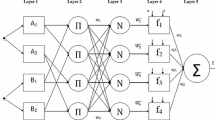Abstract
In this paper, an adaptive-network-based fuzzy inference system (ANFIS) based scheme is analyzed and proposed for reducing the peak-to-average power ratio (PAPR) in multicarrier signals under additive white Gaussian noise and multipath fading (Raleigh) channel environment. This scheme involves training of ANFIS structure in time domain using Orthogonal Frequency Division Multiplexing signals with low PAPR, such as those obtained by approximate gradient project–null subcarrier switching (AGP–NCS) method. Once the ANFIS module is trained, the proposed scheme approximately offers similar reduction in PAPR as compared to AGP–NCS method, with significantly less convergence time and computational complexity. he results show that proposed approach is not only less complex but also maintains the data rate and bit error rate performance compared with other conventional schemes.








Similar content being viewed by others
References
Litsyn, S. (2007). Peak power control in multicarrier communications. Cambridge: cambridge University Press.
Md Mahmudul Hasan. (2014). A novel CVM precoding scheme for PAPR reduction in OFDM transmissions. Wireless Networks, 20(6), 1573–1581.
Baig, I., Jeoti, V., Ikram, A. A., & Ayaz, Muhammad. (2014). PAPR reduction in mobile WiMAX: A novel DST precoding based random interleaved OFDMA uplink system. Wireless Networks, 20(5), 1213–1222.
Jiang, T., & Yiyan, Wu. (2008). An overview: Peak-to-average power ratio reduction techniques for OFDM signals. IEEE Transactions on Broadcasting, 54(2), 257–268.
Han, S. H., & Lee, J. H. (2005). An overview of peak-to-average power ratio reduction techniques for multicarrier transmission. IEEE Wireless Communications, 12(2), 56–65.
Cimini, L. J., & Sollenberger, N. R. (2000). Peak-to-average power ratio reduction of an OFDM signal using partial transmit sequences. IEEE Communication Letters, 4(3), 86–88.
Lee, Byung Moo, Kim, Youngok, & de Figueiredo, Rui J. P. (2012). Performance analysis of the clipping scheme with SLM technique for PAPR reduction. Wireless Personal Communications, 63, 331–344.
Krongold, B. S., & Jones, D. L. (2003). PAR reduction in OFDM via active constellation extension. IEEE Transaction on Broadcasting, 49(3), 258–268.
Devlin, C. A., Zhu, A., & Brazil, T. J. (2008). Peak to average power ratio reduction technique for OFDM using pilot tones and unused carriers. In IEEE Radio and Wireless Symposium (pp. 33–36).
Wong, K. T., Wang, B., & Chen, J.-C. (2011). OFDM PAPR reduction by switching null subcarriers and data subcarriers. IEEE Electronics Letters, 47(1), 62–63.
Wang, Bo, Ho, Pin-Han, & Lin, Chih-Hao. (2012). OFDM PAPR reduction by shifting null subcarriers among data subcarriers. IEEE Communications Letters, 16(9), 62–63.
Mishra, A., Saxena, R., & Patidar, M. (2015). AGP–NCS scheme for PAPR reduction. Wireless Personal Communication. doi:10.1007/s11277-015-2275-8.
Mishra, A., Saxena, R., & Patidar, M. (2014). OFDM link with a better performance using artificial neural network. Wireless Personal Communication, 77, 1477–1487.
Majumdar, K., & Das, Nabanita. (2005). Mobile user tracking using a hybrid neural network. Wireless Networks, 11(3), 275–284.
Shen, X., Mark, Jon W., & Ye, Jun. (2000). User mobility profile prediction: An adaptive fuzzy inference approach. Wireless Networks, 6(5), 363–374.
Emiroğlu, M., Beycioğlu, A., & Yildiz, S. (2012). ANFIS and statistical based approach to prediction the peak pressure load of concrete pipes including glass fiber. Expert Systems with Applications, 39(3), 2877–2883.
Yesiloglu-Gultekin, N., Sezer, E. A., Gokceoglu, C., & Bayhan, H. (2013). An application of adaptive neuro fuzzy inference system for estimating the uniaxial compressive strength of certain granitic rocks from their mineral contents, Expert Systems with Applications. Expert Systems with Applications, 40(3), 921–928.
Petković, Dalibor, Issa, Mirna, & Pavlović, Nenad D. (2013). Intelligent rotational direction control of passive robotic joint with embedded sensors. Expert Systems with Applications, 40(4), 1265–1273.
Jang, J.-S. R. (1995). Adaptive-network-based fuzzy inference system. IEEE Transaction on Commununications, 43(6), 2111–2117.
Takagi, H., & Sugeno, M. (1983). Derivation of fuzzy control rules from human operator’s control actions. In Proceedings of the IFAC symposium on fuzzy information, knowledge representation and decision analysis (pp. 55–60).
Roger Jang, J.-S. (1991). Fuzzy modeling using generalized neural networks and Kalman filter algorithm. In Proceedings of the ninth National conference on artificial intelligence (AAAI-91) (pp. 762–767).
Louliej, A., Jabrane, Y., Said, B. A. E., & Ouahman, A. A. (2013). Peak to average power ratio reduction in ECMA-368 ultra wideband communication systems using active constellation extension. Wireless Personal Communications, 70, 667–694.
Author information
Authors and Affiliations
Corresponding author
Rights and permissions
About this article
Cite this article
Mishra, A., Zaheeruddin PAPR Reduction in OFDM Signals: An Adaptive-Network-Based Fuzzy Inference Approach. Wireless Pers Commun 92, 587–601 (2017). https://doi.org/10.1007/s11277-016-3558-4
Published:
Issue Date:
DOI: https://doi.org/10.1007/s11277-016-3558-4




